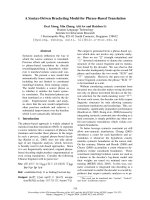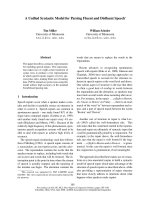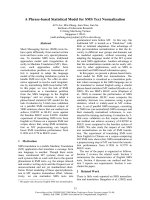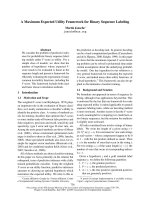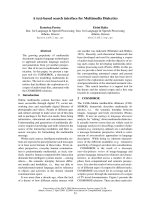Báo cáo khoa học: "A Morphologically Sensitive Clustering Algorithm for Identifying Arabic Roots" docx
Bạn đang xem bản rút gọn của tài liệu. Xem và tải ngay bản đầy đủ của tài liệu tại đây (46.87 KB, 8 trang )
A Morphologically Sensitive Clustering Algorithm for Identifying
Arabic Roots
Anne N. DE ROECK
Department of Computer Science
University of Essex
Colchester, CO4 3SQ, U.K.
Waleed AL-FARES
Computer Science Department
College of Business Studies,
Hawaly, Kuwait
Abstract
We present a clustering algorithm for Arabic
words sharing the same root. Root based
clusters can substitute dictionaries in
indexing for IR. Modifying Adamson and
Boreham (1974), our Two-stage algorithm
applies light stemming before calculating
word pair similarity coefficients using
techniques sensitive to Arabic morphology.
Tests show a successful treatment of infixes
and accurate clustering to up to 94.06% for
unedited Arabic text samples, without the
use of dictionaries.
Introduction
Canonisation of words for indexing is an
important and difficult problem for Arabic IR.
Arabic is a highly inflectional language with
85% of words derived from tri-lateral roots (Al-
Fedaghi and Al-Anzi 1989). Stems are derived
from roots through the application of a set of
fixed patterns. Addition of affixes to stems
yields words. Words sharing a root are
semantically related and root indexing is
reported to outperform stem and word indexing
on both recall and precision (Hmeidi et al 1997).
However, Arabic morphology is excruciatingly
complex (the Appendix attempts a brief
introduction), and root identification on a scale
useful for IR remains problematic.
Research on Arabic IR tends to treat automatic
indexing and stemming separately. Al-Shalabi
and Evans (1998) and El-Sadany and Hashish
(1989) developed stemming algorithms. Hmeidi
et al (1997) developed an information retrieval
system with an index, but does not explain the
underlying stemming algorithm. In Al-Kharashi
and Evans (1994), stemming is done manually
and the IR index is built by manual insertion of
roots, stems and words.
Typically, Arabic stemming algorithms operate
by “trial and error”. Affixes are stripped away,
and stems “undone”, according to patterns and
rules, and with reference to dictionaries. Root
candidates are checked against a root lexicon. If
no match is found, affixes and patterns are re-
adjusted and the new candidate is checked. The
process is repeated until a root is found.
Morpho-syntactic parsers offer a possible
alternative to stemming algorithms. Al-Shalabi
and Evans (1994), and Ubu-Salem et al (1999)
develop independent analysers. Some work
builds on established formalisms such a DATR
(Al-Najem 1998), or KIMMO. This latter strand
produced extensive deep analyses. Kiraz (1994)
extended the architecture with multi-level tape,
to deal with the typical interruption of root letter
sequences caused by broken plural and weak
root letter change. Beesley (1996) describes the
re-implementation of earlier work as a single
finite state transducer between surface and
lexical (root and tag) strings. This was refined
(Beesley 1998) to the current on-line system
capable of analysing over 70 million words.
So far, these approaches have limited scope for
deployment in IR. Even if substantial, their
morpho-syntactic coverage remains limited and
processing efficiency implications are often
unclear. In addition, modern written Arabic
presents a unique range of orthographic
problems. Short vowels are not normally written
(but may be). Different regional spelling
conventions may appear together in a single text
and show interference with spelling errors.
These systems, however, assume text to be in
perfect (some even vowelised) form, forcing the
need for editing prior to processing. Finally, the
success of these algorithms depends critically on
root, stem, pattern or affix dictionary quality,
and no sizeable and reliable electronic
dictionaries exist. Beesley (1998) is the
exception with a reported 4930 roots encoded
with associated patterns, and an additional affix
and non-root stem lexicon
1
. Absence of large
and reliable electronic lexical resources means
dictionaries would have to be updated as new
words appear in the text, creating a maintenance
overhead. Overall, it remains uncertain whether
these approaches can be deployed and scaled up
cost-effectively to provide the coverage required
for full scale IR on unsanitised text.
Our objective is to circumvent morpho-
syntactic analysis of Arabic words, by using
clustering as a technique for grouping words
sharing a root. In practise, since Arabic words
derived from the same root are semantically
related, root based clusters can substitute root
dictionaries for indexing in IR and furnish
alternative search terms. Clustering works
without dictionaries, and the approach removes
dictionary overheads completely. Clusters can
be implemented as a dimension of the index,
growing dynamically with text, and without
specific maintenance. They will accommodate
effortlessly a mixture of regional spelling
conventions and even some spelling errors.
1 Clustering and Arabic.
To our knowledge, there is no application of
automatic root-based clustering to Arabic, using
morphological similarity without dictionary.
Clustering and stemming algorithms have
mainly been developed for Western European
languages, and typically rely on simple heuristic
rules to strip affixes and conflate strings. For
instance, Porter (1980) and Lovins (1968)
confine stemming to suffix removal, yet yield
acceptable results for English, where roots are
relatively inert. Such approaches exploit the
morphological frugality of some languages, but
do not transfer to heavily inflected languages
such as Arabic.
In contrast, Adamson and Boreham (1974)
developed a technique to calculate a similarity
co-efficient between words as a factor of the
number of shared sub-strings. The approach
(which we will call Adamson’s algorithm for
short) is a promising starting point for Arabic
1
Al-Fedaghi and Al-Anzi (1989) estimate there are
around 10,000 independent roots.
clustering because affix removal is not critical to
gauging morphological relatedness.
In this paper, we explain the algorithm, apply
it to raw modern Arabic text and evaluate the
result. We explain our Two-stage algorithm,
which extends the technique by (a) light
stemming and (b) refinements sensitive to
Arabic morphology. We show how the
adaptation increased successful clustering of
both the original and new evaluation data.
2 Data Description
We focus on IR, so experiments use modern,
unedited Arabic text, with unmarked short
vowels (Stalls and Knight 1998). In all we
constructed five data sets. The first set is
controlled, and was designed for testing on a
broad spectrum of morphological variation. It
contains selected roots with derived words
chosen for their problematic structure, featuring
infixes, root consonant changes and weak letters.
It also includes superficially similar words
belonging to different roots, and examples of
hamza as a root consonant, an affix and a silent
sign. Table 1 gives details.
Table 1: Cluster size for 1
st
data set
root size root size
ktb wrote 49 HSL obtained 7
qwm straightened 38 s’aL asked 6
mr passed 26 HSd cultivated 5
wSL linked 11 shm shared 4
r’as headed 10
Data sets two to four contain articles extracted
from Al-Raya (1997), and the fifth from Al-
Watan (2000), both newspapers from Qatar.
Following Adamson, function words have been
removed. The sets have domain bias with the
second (575 words) and the fourth (232 words)
drawn randomly from the economics and the
third (750 words) from the sports section. The
fifth (314 words) is a commentary on political
history. Sets one to three were used to varying
extents in refining our Two-stage algorithm. Sets
four and five were used for evaluation only.
Electronically readable Arabic text has only
recently become available on a useful scale,
hence our experiments were run on short texts.
On the other hand, the coverage of the data sets
allows us to verify our experiments on
demanding samples, and their size lets us verify
correct clustering manually.
3. Testing Adamson’s Algorithm
3.1 The Algorithm
Adamson and Boreham (1974) developed a
technique expressing relatedness of strings as a
factor of shared sub-strings. The algorithm drags
an n-sized window across two strings, with a 1
character overlap, and removes duplicates. The
strings' similarity co-efficient (SC) is calculated
by Dice’s equation: SC (Dice) = 2*(number of
shared unique n-grams)/(sum of unique n-grams
in each string)
Table 2: Adamson's Algorithm Illustrated
String 2-grams Unique 2-grams
phosphorus ph ho os sp ph
ho or ru us
ph ho os sp or ru
us (7)
phosphate ph ho os sp ph
ha at te
ph ho os sp ha at
te (7)
Shared unique 2-grams
ph ho os sp (4)
SC (Dice) = 2(4)/(7+7) = 0.57
After the SC for all word pairs is known, the
single link clustering algorithm is applied. A
similarity (or dissimilarity) threshold is set. The
SC of pairs is collected in a matrix. The
threshold is applied to each pair’s SC to yield
clusters. A cluster absorbs a word as long as its
SC to another cluster item exceeds the threshold
(van Rijsbergen 1979). Similarity to a single
item is sufficient. Cluster size is not pre-set.
3.2 Background Assumptions
This experiment tests Adamson's algorithm on
Arabic data to assess its ability to cluster words
sharing a root. Each of the data sets was
clustered manually to provide an ideal
benchmark. This task was executed by a native
Arabic speaker with reference to dictionaries.
Since we are working with very small texts, we
sought to remove the effects of sampling in the
tests. To assess Adamson’s algorithm’s potential
for clustering Arabic words, we preferred to
compare instances of optimal performance. We
varied the SC to yield, for each data set, the
highest number of correct multi-word clusters.
Note that the higher the SC cut-off, the less
likely that words will cluster together, and the
more single word clusters will appear. This has
the effect of growing the number of correct
clusters because the proportion of correct single
word clusters will increase. As a consequence,
for our purposes, the number of correct multi-
word clusters (and not just correct clusters) are
an important indicator of success.
A correct multi-word cluster covers at least
two words and is found in the manual
benchmark. It contains all and only those words
in the data set which share a root. Comparison
with a manual benchmark inevitably introduces
a subjective element. Also, our evaluation
measure is the percentage of correct benchmark
clusters retrieved. This is a “recall” type
indicator. Together with the strict definition of
correct cluster, it cannot measure cluster quality.
Finer grained evaluation of cluster quality would
be needed in an IR context.
However, our main concern is comparing
algorithms. The current metrics aim for a
conservative gauge of how Adamson’s
algorithm can yield more exact clusters from a
full range of problematic data.
Table 3: Adamson's Algorithm Test Results
Data set Set 1 Set 2 Set 3 Set 4 Set 5
Benchmark:
Total Manual Clusters(A)
9 267 337 151 190
Multi-word (B)
9 130 164 50 63
Single word (C)
0 137 173 101 127
SC cut-off
2
0.50 0.54 0.75 0.58-0.60 0.61-0.66
Test:(% of Benchmark)
Correct Clusters (% of A)
11.11% 56.55% 60.83% 70.86% 74.21%
Multi-word (% of B)
11.11% 38.46% 21.95% 40% 34.92%
Single word (% of C)
0.0% 73.72% 97.69% 86.14% 93.70%
2
Ranges rather than specific values are given where
cut-offs between the lower and higher value do not
alter cluster distribution.
Our interpretation of correct clustering is
stringent and therefore conservative, adding to
the significance of our results. Cluster quality
will be reviewed informally.
3.3 Adamson’s Arabic Test Results
Table 3 shows results for Adamson’s
algorithm. The figures for the first data set have
to be suitably interpreted. The set deliberately
did not include single word clusters.
The results suggest that the algorithm is very
successful at identifying single word clusters but
performs poorly on multi-word clusters. The
high success rate for single word clusters is
partly due to the high SC cut-off, set to yield as
many correct multi-word clusters as possible.
In terms of quality, however, only a small
proportion of multi-word clusters were found to
contain infix derivations (11.11%, 4.76%, 0.0%
4.35% and 9.09% for each data set respectively),
as opposed to other variations. In other words,
strings sharing character sequences in middle
position cluster together more successfully. Infix
recognition is a weak point in this approach.
Whereas the algorithm is successful for
English, it is no surprise that it should not
perform equally well on Arabic. Arabic words
tend to be short and the chance of words derived
from different roots sharing a significant
proportion of characters is high (eg K
h
br (news)
vs K
h
bz (bread)). Dice’s equation assumes the
ability to identify an uninterrupted sequence of
root consonants. The heavy use of infixes runs
against this. Similarly, affixes cause interference
(see 4.1.1).
4 The Two-Stage Algorithm.
The challenge of root based clustering for
Arabic lies in designing an algorithm which will
give relevance to root consonants only. Using
Adamson’s algorithm as a starting point, we
devised a solution by introducing and testing a
number of successive refinements based on the
morphological knowledge and the first three
data sets. The rationale motivating these
refinements is given below.
4.1 Refinements
4.1.1 Affixes and light stemming:
The high incidence of affixes keeps accurate
cluster formation low, because it increases the
SC among words derived from different roots,
and lowers the SC between derivations of the
same root using different affixes, as illustrated in
tables 4 and 5. Following Popovic and Willet
(1992), we introduced stemming to minimise the
effect of affixes. We found empirically that light
stemming, removing a small number of obvious
affixes, gave better results than heavy stemming
aimed at full affix stripping. Heavy stemming
brought the risk of root consonant loss (eg
t’amyn (insurance) from root amn (sheltered):
heavy stemming: t’am, light stemming: t’amn).
Light stemming, on the other hand, does little
more than reducing word size to 3 or 4
characters.
4.1.2 Weak letters, infixes and “cross”:
Weak letters (alif, waw, ya) occur freely as
root consonants as well as affixes. Under
derivation, their form and location may change,
or they may disappear. As infixes, they interfere
with SC, causing failure to cluster (table 6).
Their effects were reduced by a method we refer
to as “cross”. It adds a bi-gram combining the
letters occurring before and after the weak letter.
Table 4: Inflected words from different roots: ?Lm (learned) and arb (arabised)
String Unique 2-grams with affixes Unique 2-grams without affixes
aL?aLmyh (the universal) aL L? ?a Lm my yh (6) ?a Lm (2)
aL?rbyh (the Arabic) aL L? ?r rb by yh (6) ?r rb (2)
SC (Dice)
2(3)/(6+6) = 0.50 2(0)/(2+2) = 0
Table 5: Inflected words from the same root: mrr (passed)
String Unique 2-grams with affixes Unique 2-grams without affixes
mstmr (continuous) ms st tm mr (4) mr (1)
mr (passed) mr (1) mr (1)
SC (Dice)
2(1)/(4+1) = 0.40 2(1)/(1+1) = 1.0
Table 6: Infix derivation from root wqf (stopped) - post light stemming
String Unique 2-grams without cross Unique di-grams with cross
qaf qa af (2) qa af qf (3)
wqf wq qf (2) wq qf (2)
SC (Dice)
2(0)/(2+2) = 0 2(1)/(2+3) = 0.4
4.1.3 Suspected affixes and differential
weighting:
Our objective is to define an algorithm which
gives suitable precedence to root consonants.
Light stemming, however does not remove all
affixes. Whereas fool proof affix detection is
problematic due to the overlap between affix and
root consonants, affixes belong to a closed class
and it is possible to identify “suspect” letters
which might be part of an affix.
Following Harman (1991) we explored the
idea of assigning differential weights to sub-
strings. Giving equal weight of 1 to all
substrings equates the evidence contributed by
all letters, whether they are root consonants or
not. Suspected affixes, however, should not be
allowed to affect the SC between words on a par
with characters contributing stronger evidence.
We conducted a series of experiments with
differential weightings, and determined
empirically that 0.25 weight for strings
containing weak letters, and 0.50 for strings
containing suspected non-weak letter affixes
gave the best SC for the first three data sets.
4.1.4 Substring boundaries:
N-gram size can curtail the significance of
word boundary letters (Robertson and Willet
1992). To give them opportunity to contribute
fully to the SC, we introduced word boundary
blanks (Harman 1991).
Also, the larger the n-gram, the greater its
capacity to mask the shorter substring which can
contain important evidence of similarity between
word pairs (Adamson and Boreham 1974). Of
equal importance is the size of the sliding
overlap between successive n-grams (Adams
1991).
Table 7: Blank insertion with “cross”
String Unique 2-grams (no)
qaf *q qa af qf f* (5)
wqf *w wq *q qf f* (5)
SC (Dice)
2(3)/(5+5) = 0.60
The problem is to find the best setting for n-
gram and overlap size to suit the language. We
sought to determine settings experimentally. Bi-
grams with single character overlap and blank
insertion (* in the examples) at word boundaries
raised the SC for words sharing a root in our
three data sets, and lowered the SC for words
belonging to different roots.
4.1.5 SC formula:
Dice’s equation boosts the importance of
unique shared substrings between word pairs, by
doubling their evidence. As we argued earlier,
since Arabic words tend to be short, the relative
impact of shared substrings will already be
dramatic. We replaced the Dice metric with the
Jaccard formula below to reduce this effect (see
van Rijsbergen 1979). SC (Jac) = shared unique
n-grams/(sum of unique n-grams in each string -
shared unique n-grams)
4.2 The Two-stage Algorithm
The Two-stage algorithm is fully implemented.
Words are first submitted to light stemming to
remove obvious affixes. The second stage is
based on Adamson’s algorithm, modified as
described above. From the original, we retained
bi-grams with a one character overlap, but
inserted word boundary blanks. Unique bi-grams
are isolated and cross is implemented. Each bi-
gram is assigned a weight (0.25 for bi-grams
containing weak letters; 0.5 for bi-grams
containing potential non-weak letter affixes; 1
for all other bi-grams). Jaccard’s equation
computes a SC for each pair of words. We
retained the single-link clustering algorithm to
ensure comparability.
4.3 Testing the Two-stage Algorithm
Table 8 shows the results of the Two-stage
algorithm for our data sets. The maximally
effective cut of point for all sets lies closer.
Figures for the first set have to be treated with
caution. The perfect clustering is explained by
the text’s perfect spelling and by the sample
containing exactly those problematic phenomena
on which we wanted to concentrate.
Table 8: Two-stage Algorithm Test Results
Data set Set 1 Set 2 Set 3 Set 4 Set 5
Benchmark:
Total Manual Clusters (A)
9 267 337 151 190
Multi-word (B)
9 130 164 50 63
Single word (C)
0 137 173 101 127
SC cut-off
0.42-0.66 0.54 0.54 0.53-0.54 0.62-0.66
Test: (% of Benchmark)
Correct Clusters (% of A)
100% 88.05% 86.94% 94.04% 86.84%
Multi-word (% of B)
100% 85.39% 82.93% 94% 74.60%
Single word (% of C)
- 90.51% 90.75% 94.06% 92.91%
The algorithm deals with weak letter mutation,
and infix appearance and disappearance in
words sharing a root (eg the root qwm and its
derived words, especially the role of Hamza as
an infix in one of its variations). Even though
the second and third data sets informed the
modifications to a limited extent, their results
show that the improvements stood up to free
text. For the second data set, the Two-stage
algorithm showed 31.5% improvement over
Adamson’s algorithm. Importantly, it discovered
84.13% of the multi-word clusters containing
words with infixes, an improvement of 79.37%.
The values for single word clustering are close
and the modifications preserved the strength of
Adamson’s algorithm in keeping single word
clusters from mixing, because we were able to
maintain a high SC threshold.
On the third data set, the Two-stage algorithm
showed an 26.11% overall improvement, with
84% successful multi-word clustering of words
with infixes (compare 0% for Adamson). The
largest cluster contained 14 words. 10 clusters
counted as unsuccessful because they contained
one superficially similar variation belonging to a
different root (eg TwL (lengthened) and bTL (to
be abolished)). If we allow this error margin, the
success rate of multi-word clustering rises to
90%. Since our SC cut-off was significantly
lower than in Adamson’s base line experiment,
we obtained weaker results for single word
clustering.
The fourth and fifth data sets played no role in
the development of our algorithm and were used
for evaluation purposes only. The Two-stage
algorithm showed an 23.18% overall
improvement in set four. It successfully built all
clusters containing words with infixes (100% -
compare with 4.35% for Adamson’s algorithm),
an improvement of 95.65%. The two-stage
algorithm again preserved the strength of
Adamson at distinguishing single word clusters,
in spite of a lower SC cut-off.
The results for the fifth data set are particularly
important because the text was drawn from a
different source and domain. Again, significant
improvements in multi and single word
clustering are visible, with a slightly higher SC
cut-off. The algorithm performed markedly
better at identifying multi-word clusters with
infixes (72.72% - compare with 9.09% for
Adamson).
The results suggest that the Two-stage
algorithm preserves the strengths of Adamson
and Boreham (1994), whilst adding a marked
advantage in recognising infixes. The outcome
of the evaluation on fourth and fifth data sets are
very encouraging and though the samples are
small, they give a strong indication that this kind
of approach may transfer well to text from
different domains on a larger scale.
5 Two-stage Algorithm Limitations
Weak letters can be root consonants, but our
differential weighting technique prevents them
from contributing strong evidence, whereas non-
weak letters featuring in affixes, are allowed to
contribute full weight. Modifying this
arrangement would interfere with successful
clustering (eg after light stemming: t is a root
consonant in ntj (produced) and an infix in Ltqy
(from root Lqy - encountered). These limitations
are a result of light stemming.
Although the current results are promising,
evaluation was hampered by the lack of a
sizeable data set to verify whether our solution
would scale up.
Conclusion
We have developed, successfully, an automatic
classification algorithm for Arabic words which
share the same root, based only on their
morphological similarities. Our approach works
on unsanitised text. Our experiments show that
algorithms designed for relatively uninflected
languages can be adapted for highly inflected
languages, by using morphological knowledge.
We found that the Two-stage algorithm gave a
significant improvement over Adamson’s
algorithm for our data sets. It dealt successfully
with infixes in multi-word clustering, an area
where Adamson’s algorithm failed. It matched
the strength of Adamson in identifying single
word clusters, and sometimes did better. Weak
letters and the overlap between root and affix
consonants continue to cause interference.
Nonetheless, the results are promising and
suggest that the approach may scale up
Future work will concentrate on two issues.
The light stemming algorithm and the
differential weighting may be modified to
improve the identification of affixes. The extent
to which the algorithm can be scaled up must be
tested on a large corpus.
Acknowledgements
Our thanks go to the Kuwait State's Public
Authority for Applied Education and Training,
for the supporting research studentship, and to
two anonymous referees for detailed, interesting
and constructive comments.
Appendix - Arabic in a Nutshell
The vast majority of Arabic words are derived
from 3 (and a few 4) letter roots via a complex
morphology. Roots give rise to stems by the
application of a set of fixed patterns. Addition of
affixes to stems yields words.
Table 9: Stem Patterns
Root Pattern Stem
ktb wrote fa?L katb writer
mf?wL mktwb document
qtL killed fa?L qatL killer
mf?wL mqtwL corpse
Table 9 shows examples of stem derivation
from 3-letter roots. Stem patterns are formulated
as variations on the characters f?L (pronounced
as f'l - ? is the symbol for ayn, a strong glottal
stop), where each of the successive consonants
matches a character in the bare root (for ktb, k
matches f, t matches ? and b matches L). Stems
follow the pattern as directed. As the examples
show, each pattern has a specific effect on
meaning. Several hundred patterns exist, but on
average only about 18 are applicable to each
root (Beesley 1998).
The language distinguishes between long and
short vowels. Short vowels affect meaning, but
are not normally written. However, patterns may
involve short vowels, and the effects of some
patterns are indistinguishable in written text.
Readers must infer the intended meaning.
Affixes may be added to the word, either under
derivation, or to mark grammatical function. For
instance, walktab breaks down as w (and) + al
(the) + ktab (writers, or book, depending on the
voweling). Other affixes function as person,
number, gender and tense markers, subject and
direct object pronouns, articles, conjunctions and
prepositions, though some of these may also
occur as separate words (eg wal (and the)).
Arabic morphology presents some tricky NLP
problems. Stem patterns “interdigitate” with root
consonants, which is difficult to parse. Also, the
long vowels a (alif), w (waw) and y (ya) can
occur as root consonants, in which case they are
considered to be weak letters, and the root a
weak root. Under certain circumstances, weak
letters may change shape (eg waw into ya) or
disappear during derivation. Long vowels also
occur as affixes, so identifying them as affix or
root consonant is often problematic.
The language makes heavy use of infixes as
well as prefixes and suffixes, all of which may
be consonants or long vowels. Apart from
breaking up root letter sequences (which tend to
be short), infixes are easily confused with root
consonants, whether weak or not. The problem
for affix detection can be stated as follows: weak
root consonants are easily confused with long
vowel affixes; consonant affixes are easily
confused with non-weak letter root consonants.
Erroneus stripping of affixes will yield the
wrong root.
Arabic plurals are difficult. The dual and some
plurals are formed by suffixes, in which case
they are called external plurals. The broken, or
internal plural, however, changes the internal
structure of the word according to a set of
patterns. To illustrate the complexity, masculine
plurals take a -wn or -yn suffix, as in mhnds
(engineer), mhndswn. Female plurals add the -at
suffix, or change word final -h to -at, as in
mdrsh (teacher), mdrsat. Broken plurals affect
root characters, as in mal (fund from root mwl),
amwal, or wSL (link from root wSL), ‘aySaL.
The examples are rife with long vowels (weak
letters?). They illustrate the degree of
interference between broken plural patterns and
other ways of segmenting words.
Regional spelling conventions are common:
eg. three versions of word initial alif occur. The
most prominent orthographic problem is the
behaviour of hamza, (’), a sign written over a
carrier letter and sounding a lenis glottal stop
(not to be confused with ayn). Hamza is not
always pronounced. Like any other consonant, it
can take a vowel, long or short. In word initial
position it is always carried by alif, but may be
written above or below, or omitted. Mid-word it
is often carried by one of the long vowels,
depending on rules whose complexity often
gives rise to spelling errors. At the end of words,
it may be carried or written independently.
Hamza is used both as a root consonant and an
affix, and is subject to the same problems as
non-weak letter consonants, compounded by
unpredictable orthography: identical words may
have differently positioned hamzas and would
be considered as different strings.
References
Adams, E. (1991) A Study of Trigrams and their
feasibility as Index Terms in a full text Information
Retrieval System. PhD Thesis, George Washington
University, USA.
Adamson, George W. and J. Boreham (1974) The
use of an association measure based on character
structure to identify semantically related pairs of
words and document titles. Information Storage
and Retrieval,. Vol 10, pp 253-260
Al-Fedaghi Sabah S. and Fawaz Al-Anzi (1989) A
new algorithm to generate Arabic root-pattern
forms. Proceedings of the 11th National Computer
Conference, King Fahd University of Petroleum &
Minerals, Dhahran, Saudi Arabia., pp04-07
Al-Kharashi, I. and M. Evens (1994) Comparing
words, stems, and roots as Index terms in an
Arabic Information Retrieval system. Journal of the
American Society for Information Science, 45/8,
pp. 548-560
Al-Najem, Salah R. (1998). An Explanation of
Computational Arabic Morphology. DATR
Documentation Report, University of Sussex.
Al-Raya (1997) Newspaper. Quatar.
Al-Shalabi, R. and M. Evens (1998) A
Computational Morphology System for Arabic.
Proceedings of COLING-ACL, New Brunswick,
NJ.
Al-Watan (2000) Newspaper. Qatar.
Beesley, K.B. (1996) Arabic Finite-State
Morphological Analysis and Generation.
Proceedings of COLING-96, pp 89-94.
Beesley, K.B. (1998) Arabic Morphological Analysis
on the Internet. Proceedings of the 6
th
International
Conference and Exhibition on Multi-Lingual
Computing, Cambridge.
El-Sadany, T. and M. Hashish (1989) An Arabic
morphological system. IBM System Journal, 28/4
Harman, D. (1991) How effective is suffixing?
Journal of the American Society for Information
Science, 42/1, pp 7-15.
Hmeidi, I., Kanaan, G. and M. Evens (1997) Design
and Implementation of Automatic Indexing for
Information Retrieval with Arabic Documents.
Journal of the American Society for Information
Science, 48/10, pp. 867-881.
Kiraz, G. (1994) Multi-tape two-level Morphology: a
case study in Semitic non-linear morphology.
Proceedings of COLING-94, pp180-186.
Lovins, J.B. (1968) Development of a Stemming
Algorithm. Mechanical Translation and
Computational Linguistics, 11/1.
Popovic, M. and P. Willet (1992) The effectiveness
of stemming for natural language access to Sloven
textual data. Journal of the American Society for
Information Science, 43/5, pp. 384-390.
Porter, M.F. (1980) An Algorithm for suffix
stripping. Program, 14 /3, pp 130-137
Stalls, B. and Knight, K. (1998) Translating names
and technical terms in Arabic text. Proceedings of
COLING-ACL, New Brunswick, NJ, 1998
van Rijsbergen, C. J. (1979) Information Retrieval.
Butterworths, London.
Robertson, A. and Willett, P.(1992) Searching for
historical word-forms in a database of 17
th-
century
English text using spelling-correction methods. 15
th
Annual International Conference SIGIR.
Ubu-Salem H., Al-Omari M., and M. Evens (1999)
Stemming methodologies over individual query
words for an Arabic information retrieval system.
Journal of the American Society for Information
Science. 50/6, pp 524-529.


